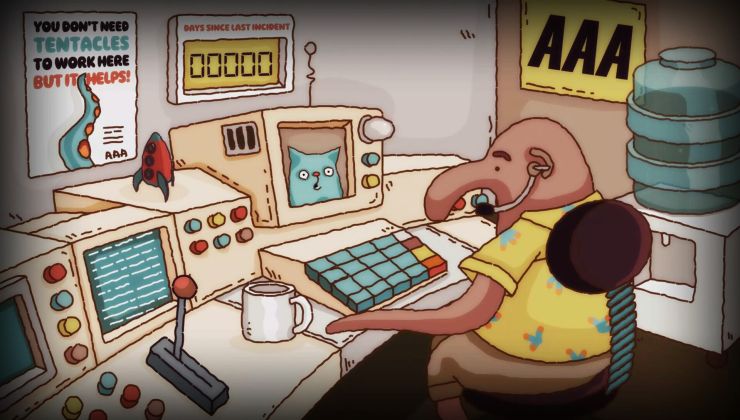Promising to be more stable and feature-filled, the Linux video editor Kdenlive has a massive new release out.
While Kdenlive 20.08 comes with a number of new features, they also went through something of a major refactor of the project files. This should fix the long standing issue with comma/point conflicting which caused a number of crashes. As a result, projects are not backwards compatible - so make backups if you're going to test the latest version. Additionally there's a performance boost with audio thumbnail generation as well as JPG image sequence playback.
As for new features? It's big. There's entirely new UI layouts, support for multiple audio streams, new cache data management to make it easier to clean up and save some space, a zoom ability on the effects panel making adjusting keyframes much easier, same with the clip monitor and much more.
 Pictured: the new "Editing" interface preset.
Pictured: the new "Editing" interface preset.
The new default interfaces are:
- Logging for reviewing your footage
- Editing to compose your story in the timeline
- Audio for mixing and adjusting your audio
- Effects for adding effects
- Color for adjusting and color grading
Quite useful, although Kdenlive's UI remains nicely configurable, so you can add/remove and adjust the size of any panels as and when you need them. With the newer defaults though, it gives it that little bit more of a polished and professional feel to it while also bringing attention to the existing layout feature.
See the release announcement here, they supply an AppImage so you should be able to use it across almost any Linux distribution without much fuss.
weird...just upgraded kdenlive to this new version and suddenly steam is broken. Any ideas?
Fizx it pull in new versions of libraries?
I think it's hard to see what might be difficult about something as soon as you are used to it. I'm seeing the same effect with many computer things myself, where I wonder how things can be done wrong...
Yeah, you're right of course. But let me tell you that when I did my last tryout of various video editors for Linux - albeit it's some years ago - I did encounter a lot of real shitty user interfaces on even the most limited editors. So it may not be all your fault :)
I think you can do what you're asking by clicking and dragging a correction from the effect menu to the little boxes to the left of the various channels (where it says by default "Video 1", "Audio 1", "Video 2", etc.). For instance I usually apply a Normalize effect to my voice audio channel as my dynamic range while narrating videos is annoyingly large
AHA! See, I THOUGHT it was so damn weird that I couldn't do an effect on an entire channel, as I said in the first post, I suspected they've hid it well. As indeed now seems to be the case.
Thanks a bunch for this!
Is this still the case or have they finally made some of their software standalone?
Fifty clips along the timeline, you want to nudge the contrast a little... Good luck with that. You need to have a very strong will on wanting to see this as an adequate solution to find this to be a good alternative. :)To be honest, I can't think of many situations where I would want to add the exact same color or contrast effect to an entire timeline since raw footage can often differ in quality to one degree or another, so I would want to tweak each shot individually in order to maintain consistency. But I suppose this would differ from project to project.
I think you can do what you're asking by clicking and dragging a correction from the effect menu to the little boxes to the left of the various channels (where it says by default "Video 1", "Audio 1", "Video 2", etc.).Good tip.
AHA! See, I THOUGHT it was so damn weird that I couldn't do an effect on an entire channel, as I said in the first post, I suspected they've hid it well. As indeed now seems to be the case.No problem, happy to help.
Thanks a bunch for this!
To be honest, I can't think of many situations where I would want to add the exact same color or contrast effect to an entire timeline since raw footage can often differ in quality to one degree or another, so I would want to tweak each shot individually in order to maintain consistency. But I suppose this would differ from project to project.
One camera productions, shorter clips/scenes, this could very much be wanted. Or if you have each camera/source on each their channels.
But there's also quite common that you would want to apply a change to the whole production for artistic/stylistic reasons. For example add a tint/shade, or colour balance or some other filter/effect.
So it is an obvious feature of a pro video editor. And, as it was now discovered, so do KDEnlive :)
No, I agree it's a feature that some people would use, but I personally never would. I did a project a couple years ago that was several hundred shots, and I tuned each one individually (primarily fixing white balance) to maintain a consistent look across the entire piece. There's no way I could have used a "one size fits all" effect for it.To be honest, I can't think of many situations where I would want to add the exact same color or contrast effect to an entire timeline since raw footage can often differ in quality to one degree or another, so I would want to tweak each shot individually in order to maintain consistency. But I suppose this would differ from project to project.One camera productions, shorter clips/scenes, this could very much be wanted. Or if you have each camera/source on each their channels.
But there's also quite common that you would want to apply a change to the whole production for artistic/stylistic reasons. For example add a tint/shade, or colour balance or some other filter/effect.
So it is an obvious feature of a pro video editor. And, as it was now discovered, so do KDEnlive :)
Last edited by Mountain Man on 20 Aug 2020 at 9:16 pm UTC
No, I agree it's a feature that some people would use, but I personally never would. I did a project a couple years ago that was several hundred shots, and I tuned each one individually (primarily fixing white balance) to maintain a consistent look across the entire piece. There's no way I could have used a "one size fits all" effect for it.
Yeah absolutely, there are cases where you need to modify each shot. Plenty.
It all depends on the user case. And if you then, after all that work were done and they were all in balance, wanted to add say a tiny nudge on the contrast or saturation - that's where the channel filtering comes in hand. Or boost the colour balance to give the entire production a pink tint (or whatever :D )
Or, to make a more common example, if you want to apply a limiter on the audio output. That's exceptionally common.
A simple tool, non-crashing please, for dummies.
Please don't make me googling how I can cut something at the beginning and the end.
Cutting videos short, maybe some simple blending.
Please have "output format like input format" option.
Try Openshot
Found it easy to use to splice some videos
I tried this and succeeded cutting off the not-so-well ending of a video of my kid. (Second attempt, in first one I managed to delete the whole stuff instead of only the ending). Exporting worked, the result is fine.
What I'm severely missing is said "output format like input format" option. I think this would be suitable for a video editor.
What I'd really want is "please do not recode at all, just dump all those frames I told you I don't want".
But I guess that's just not what video editors are all about.
I tried to install other proposals from this thread (thanks for all of them!), but unfortunately found several not to be available in Debian stable at the moment (and didn't want to experiment).
But, I'm happy enough with OpenShot.
What I'd really want is "please do not recode at all, just dump all those frames I told you I don't want".
But I guess that's just not what video editors are all about.
This is a lot about how video codecs and containers are constructed technically rather than being against the goals of video editing software. With most video containers, it is not possible to just split a file without re-encoding it.
There is a tool called MKVToolNix (and there is a GUI for it) that allows you to split videos in mkv containers while only remuxing the video rather than re-encoding it, though you are still restricted to splitting only on certain frames.
This is a lot about how video codecs and containers are constructed technically rather than being against the goals of video editing software. With most video containers, it is not possible to just split a file without re-encoding it.
I'm not aware of (and I can hardly imagine) a video format that would need reencoding of more than some frames (before the cut). Remuxing is fine and should be fast.
This is a lot about how video codecs and containers are constructed technically rather than being against the goals of video editing software. With most video containers, it is not possible to just split a file without re-encoding it.
I'm not aware of (and I can hardly imagine) a video format that would need reencoding of more than some frames (before the cut). Remuxing is fine and should be fast.
Avidemux has been mentioned already once in the discussion and it has options for copying the video and audio codec as is and it did save the file very quickly.
Speaking of Avidemux, it's actually great for small set of things it does, like cutting pieces out of the video. For serious editing something else is better. It for example doesn't support multiple video tracks.
As for the "some frames", they usually called key frames and how frequently they appear in the video can vary. They're actually like still images and subsequent frames calculate differences from that key frame until the next key frame, which will reset the situation again.
Having them more frequently means that the file is bigger, but having them on scene changes makes sense as picture will change quite drastically, so having key frame there most likely will save space.
If file has very few key frames, things will get harder as if video editor needs to show anything between the key frames, it needs to find the previous key frame and then render all the frames up to the point.
That I don't know for sure that if you actually have to re-encode anything if you cut between key-frames. At least in theory it could leave the partial stream as is and then reconstruct new key frame at cut point.
It seems at least that Avidemux does some magic and it works.
Avidemux has been mentioned already once in the discussion and it has options for copying the video and audio codec as is and it did save the file very quickly.
Unfortunately, it's one of those programs mentioned not being in the Debian repositories at the moment. I remember the user interface as not too nice, but that was... quote some time ago.
That I don't know for sure that if you actually have to re-encode anything if you cut between key-frames. At least in theory it could leave the partial stream as is and then reconstruct new key frame at cut point.
I worked in that area 20 years ago, when MPEG-2 was the thing to use and MPEG-4 still in the making.
Cutting at key frames ("I") should "cut it". You need to pay attention though that frames coming earlier in the actual clip might come later in the stream. If you want to have frame exact cutting, there might be frames ("B") that reference frames in the future. Ideally, the application would reencode those to I or "P" frames (only referencing earlier frames). The usual frequency of I frames was 2 per second back then, but that might have been subject to change.
As said, the knowledge is 20 years old, so it deteriorated and of course, technology has advanced.
Last edited by Eike on 27 Sep 2020 at 10:39 am UTC
So what? I don't need to know that. Have it pretend. I don't know what the heck LibreOffice does to a spreadsheet file when I save it--it's not my problem.What I'd really want is "please do not recode at all, just dump all those frames I told you I don't want".
But I guess that's just not what video editors are all about.
This is a lot about how video codecs and containers are constructed technically rather than being against the goals of video editing software. With most video containers, it is not possible to just split a file without re-encoding it.
So what? I don't need to know that. Have it pretend. I don't know what the heck LibreOffice does to a spreadsheet file when I save it--it's not my problem.
Remuxing should be like ten times faster, so you cannot really pretend here.
Last edited by Eike on 28 Sep 2020 at 7:13 am UTC











 How to set, change and reset your SteamOS / Steam Deck desktop sudo password
How to set, change and reset your SteamOS / Steam Deck desktop sudo password How to set up Decky Loader on Steam Deck / SteamOS for easy plugins
How to set up Decky Loader on Steam Deck / SteamOS for easy plugins
See more from me